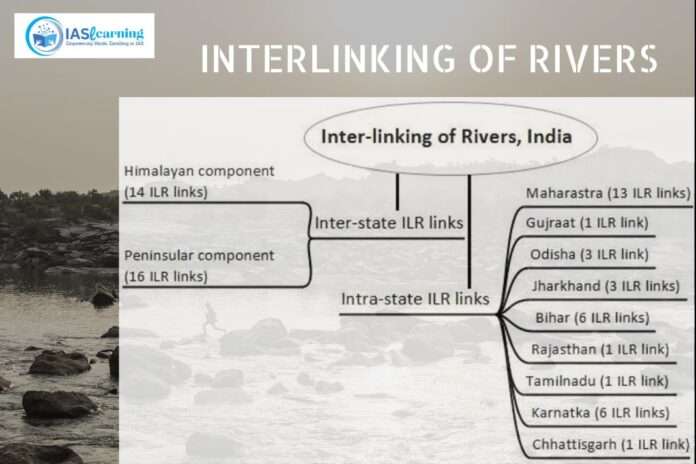Introduction to Interlinking of rivers
Interlinking of rivers in India is a proposed project aimed at connecting various rivers across the country through a network of canals and waterways. The primary objectives of this ambitious project are to address issues related to water scarcity, flood control, and efficient water resource management.
- The Indian Rivers Inter-link is a proposed large-scale civil engineering project that aims to effectively manage water resources in India by linking Indian rivers by a network of reservoirs and canals to enhance irrigation and groundwater recharge, reduce persistent floods in some parts, and water shortages in other parts of India.
- India accounts for 18% of the world’s population and about 4% of the world’s water resources. One of the solutions to solve the country’s water woes is to link rivers and lakes.
- Union Cabinet has approved the funding and implementation of Ken-Betwa inter-linking of rivers project. This project which involves transfer of water from the Ken to the Betwa River will be of immense benefit to the water starved Bundelkhand region, spread across the states of MP and UP.
- The interlinking of rivers (ILR) programme is a major endeavour to create additional storage facilities and transfer water from water-surplus regions to more drought-prone areas.
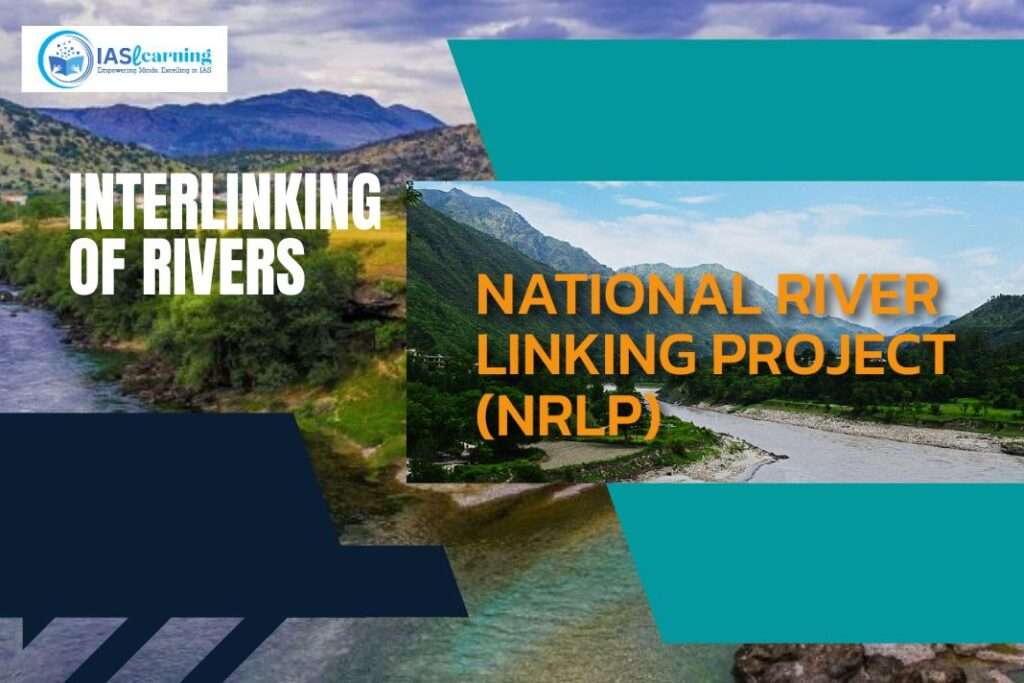
- Background:
- India faces regional disparities in the distribution of water resources, with some areas experiencing water scarcity while others face frequent floods.
- The idea of interlinking rivers was first proposed in the 19th century, but it gained significant attention in the late 20th century.
Significance Interlinking of Rivers
- Management of Floods: Many areas of India are vulnerable to regular floods, which result in casualties and damage to property. The risk of flooding in flood-prone places can be decreased by interconnecting rivers to help channel more water during the monsoons to water-deficient areas.
- Hydroelectric electricity Generation: As part of the interlinking project, dams and reservoirs will be built that can be utilized to produce hydroelectric electricity. This can help India meet its energy demands and lessen its reliance on fossil fuels.
- Water security: The accessibility of water resources varies significantly among regions in India. While some regions face disastrous monsoon floods, others have ongoing water shortages. By connecting rivers, it is possible to move water from excess to deficit areas, improving water security and availability for household, industrial, and agricultural uses.
- Agriculture and irrigation: A large majority of India’s population works in agriculture, and irrigation is essential for raising agricultural output. By connecting rivers, it is possible to transmit water to agricultural areas more easily, improving irrigation and agricultural output.
- Drought Mitigation: Drought causes significant water shortages in some locations, which causes problems for agriculture and water-related emergencies. By transporting water from water-rich regions to drought-prone ones, interconnecting rivers can help reduce the effects of drought.
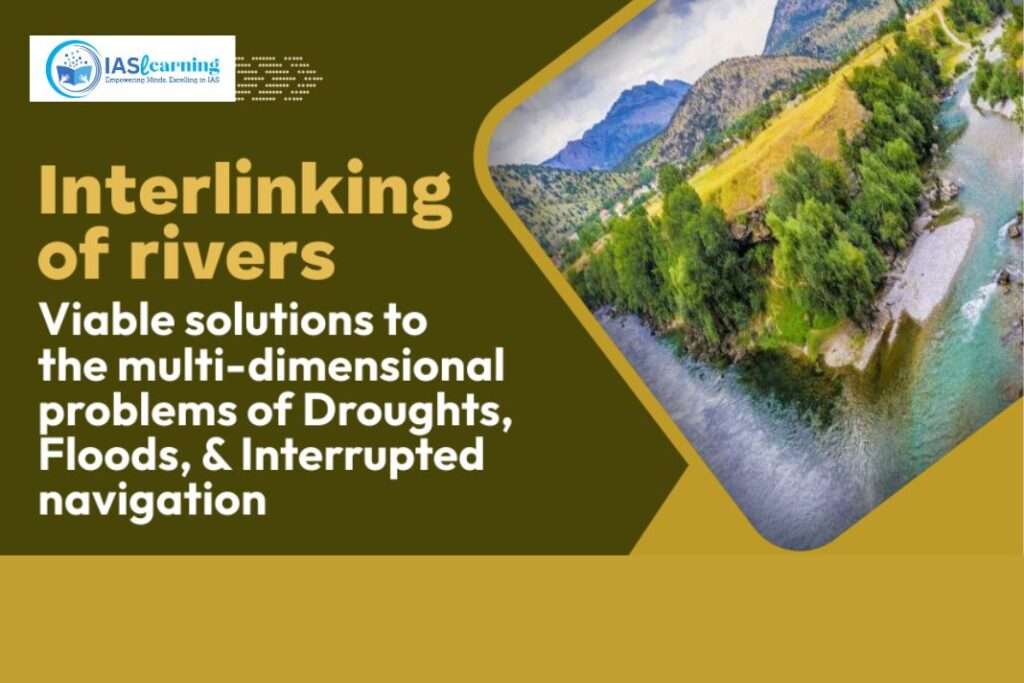
- Components:
- The project involves the construction of canals, reservoirs, and other infrastructure to divert water from surplus river basins to deficit ones.
- There are two main components: the Peninsular Rivers Development Component and the Himalayan Rivers Development Component. The former focuses on rivers in the southern and central parts of India, while the latter deals with rivers originating in the Himalayas.
Rationale behind Interlinking of Rivers
The idea behind the interlinking of rivers is that many parts of the country face problems of drought while many others face the problem of flooding every year.
- The Indo-Gangetic rivers are perennial since they are fed by rains as well as the glaciers from the Himalayas.
- The peninsular rivers in India are, however, not seasonal because they are rain-fed mainly from the south-west Monsoons.
- Due to this, the Indo-Gangetic plains suffer from floods and the peninsular states suffer from droughts.
- If this excess water can be diverted from the Plains to the Peninsula, the problem of floods and droughts can be solved to a large extent.
Hence, the National River Linking Project (NRLP) is claimed to be the answer to India’s water problem through conservation of the abundant monsoon water, store it in reservoirs, and deliver this water using rivers inter-linking project to areas and over times when water becomes scarce.
National River Linking Project
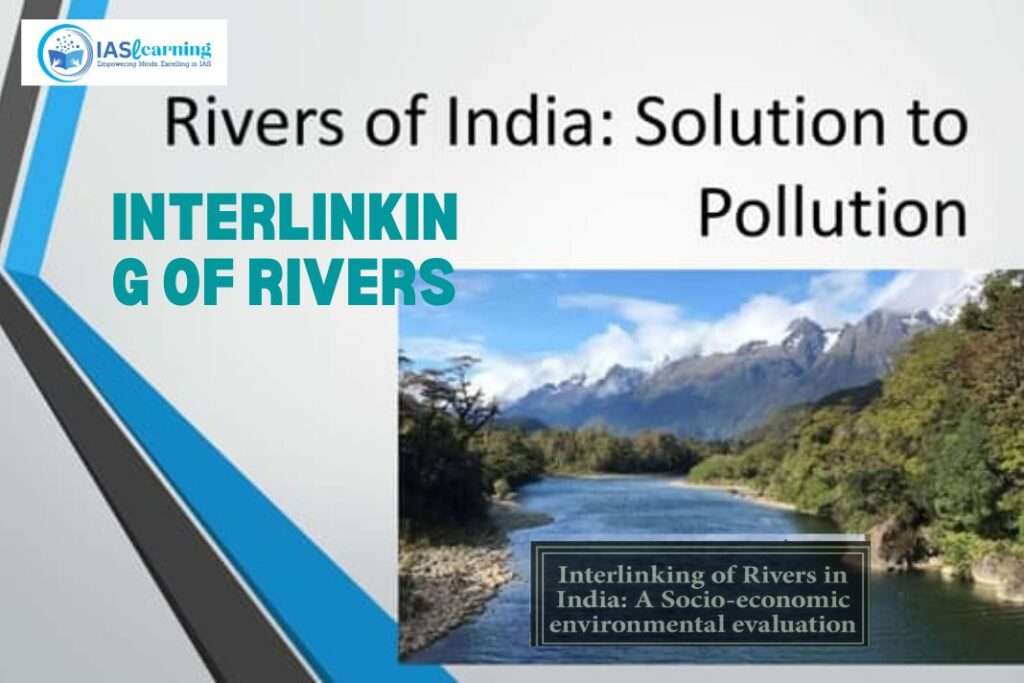
NRLP, formerly known as the National Perspective Plan, proposes to connect 14 Himalayan and 16 peninsular rivers with 30 canals and 3,000 reservoirs to form a gigantic South Asian Water Grid.
The initial plan to interlink India’s rivers came in 1858 from a British irrigation engineer, Sir Arthur Thomas Cotton.
NRLP includes two components:Himalayan component and Peninsular component
- Himalayan component: This component aims to construct storage reservoirs on the Ganga and Brahmaputra rivers, as well as their tributaries in India and Nepal. It will connect,
- The Ganga and Brahmaputra basins to the Mahanadi basin.
- The Eastern tributaries of the Ganga with the Sabarmati and Chambal river systems.
- Peninsular component: It includes 16 links that proposeto connect the rivers of South India. It envisages linking,
- The Mahanadi and Godavari to feed the Krishna, Pennar, Cauvery, and Vaigai rivers.
- The Ken river to the Betwa, Parbati, Kali sindh, and Chambal rivers.
- West-flowing rivers to the south of Tapi to the north of Bombay.
- Linking some west-flowing rivers to east-flowing rivers.
| National River Interlinking Authority The NRLP is managed by National Water Development Agency (NWDA) under the Ministry of Jal Shakti. NWDA was set up in 1982, to conduct surveys and see how feasible proposals for interlinking river projects are. Recently, it has been reported that the Centre is deliberating on creation of aNational River Interlinking Authority (NIRA). It will replace the existing National Water Development Agency (NWDA). It will coordinate with neighbouring countries and concerned states and departments and will also have powers on issues related to environment, wildlife and forest clearances under river linking projects and their legal aspects. NIRA will have the power to raise funds and act as arepository of borrowed funds or money received on deposit or loan given on interest. It will also have the power to set up aSpecial Purpose Vehicle (SPV) for individual link projects. |
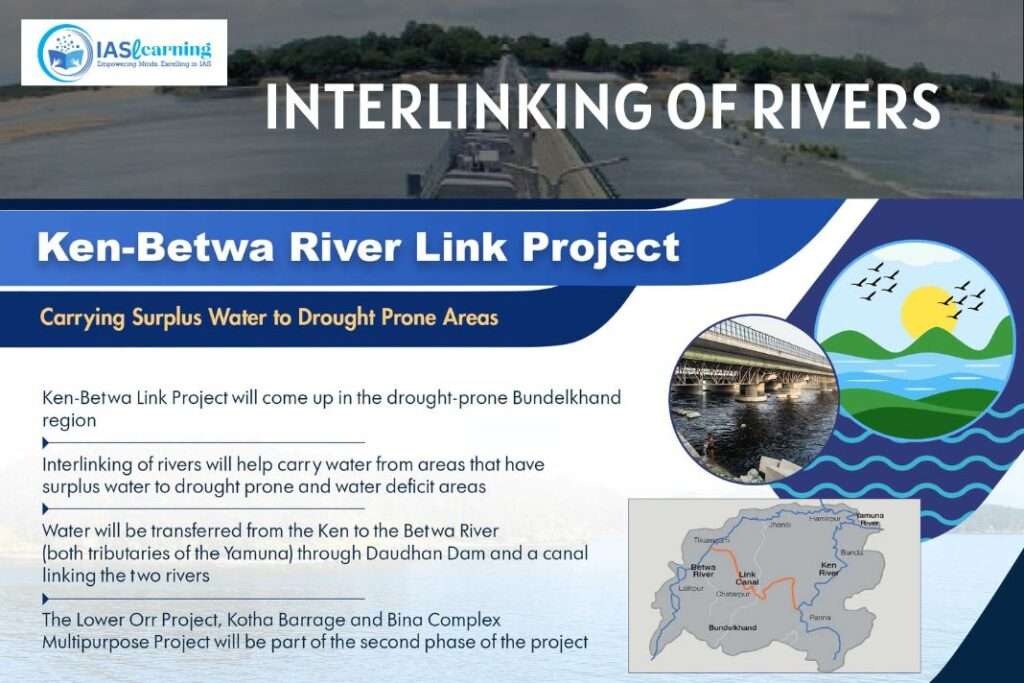
Previous examples of river-linking in India
- In the past, several river linking projects have been taken up.
- For instance,Under thePeriyar Project, transfer of water from Periyar basin to Vaigai basin was envisaged. It was commissioned in 1895.
- Similarly, other projects such as Parambikulam Aliyar, Kurnool Cudappah Canal, Telugu Ganga Project, and Ravi-Beas-Sutlej were undertaken.
- Godavari River has also been formally interlinked with the Krishna River at Ibrahimpatnam (near Vijayawada) in Andhra Pradesh in September 2015.
Important river linking project in India
- Satluj-Beas Link Canal: In order to produce electricity and expand the storage capacity of the Bhakra reservoir (Gobindsagar), the Beas-Sutlej connection project entails diverting some water from the Beas River into the Satluj River via two tunnels and an open canal.
- Mahanadi-Godavari Link: A connection between the Dowleswaram barrage on the Godavari River and the Manibhadra reservoir on the Mahanadi River has been suggested.
- Project Ken-Betwa Link: The government is paying particular attention to the ILR project’s Ken-Betwa and Parbati-Kalisindh-Chambal linkages.
- The Ken-Betwa connection aims to transfer extra water from the Ken basin to the Betwa basin, which is under water stress.
- This connecting canal will supply irrigation for a small portion of MP’s upper Betwa basin as well as for places MP and UP will pass through en-route.
- Link to Manas-Sankosh-Tista-Ganga: To help Assam, West Bengal, Bihar, Jharkhand, and Orissa, it is suggested that the Brahmaputra be connected to the Ganga, the Subarnarekha, and the Mahanadi.
- According to this link, more water might be diverted from the Manas and Sankosh rivers in the Brahmaputra basin to increase Ganga flows upstream of Farakka.
Advantages of Interlinking of Rivers
- Hydrological Imbalance of India: India has a large-scale hydrological imbalance with an effective rainfall period of 28 to 29 days. Some regions receive very high rainfall while some face droughts. Interlinking would transfer the water from flood-prone regions to draught-prone regions.
- Improve the inland navigation: Interlinking of rivers will create a network of navigation channels. Water transport is cheaper, less-polluting compare to the road and railways. Further, the interlinking of rivers can ease the pressure on railways and roads also.
- Benefit of irrigation: The interlinking of rivers has the potential to irrigate 35 million hectares of land in the water-scarce western peninsula. This will help India to create employment, boost crop outputs, farm incomes. Above all, the interlinking of rivers will make India a step closer to achieving food security.
- Generation of power: The interlinked rivers have the potential to generate a total power of 34 GW. This will help India to reduce coal-based power plant usage. Furthermore, It will also help to achieve India’s targets under Glasgow Climate Pact and under the Paris agreement.
- Water supply: The project envisages a supply of clean drinking water amounting to 90 billion cubic meter. It can resolve the issue of drinking water scarcity in India. Similarly, interlinking of rivers has the potential to provide 64.8 billion cubic meter of water for industrial use.
- Apart from that, interlinking can help the survival of fisheries, protect wildlife in the summer months due to water scarcity. It can also reduce forest fires occurring in India due to climatic conditions.
- India can also explore an additional line of defence in the form of waterline defence.
Challenges in Interlinking of Rivers
- Impact of the Climate change: Reports points out that Climate change will cause ameltdown of 1/3rd of the Hindu Kush Region’s glaciers by 2100.So, the Himalayan rivers might not have ‘surplus water’ for a long time. Also, considering this, investing billions of money in the interlinking of rivers might yield benefits only for a short time.
- Human cost: This includes the challenge of loss of livelihood and displacement of people especially, the poor and tribal people located near the forests. So, the government not only needs to face challenges in displacing people but also in the rehabilitation of people.
- Huge financial cost: NRLP is a highly capital-intensive project. In 2001, the total cost for linking the Himalayan and peninsular rivers was estimated at Rs 5,60,000 crore, excluding the costs of relief and rehabilitation, and other expenses. This cost is likely to be substantially higher now, and the cost-benefit ratio might no longer be favourable.
- Impact on ecology and biodiversity: The ecology of every river being unique, letting the waters of rivers mix may affect biodiversity. Also, when most of the rivers in the country are polluted, this may cause mixing of a less polluted river with a more polluted one.
- International Challenges: Countries like Bhutan, Nepal, and Bangladesh will be impacted due to the NRLP. Bangladesh especially fears of water diversion from the Ganga and Brahmaputra rivers to India’s southern states, threatening the livelihoods as well as its environment.
- Controlling floods: Some people express doubts as to the capability of this project to control floods. Although theoretically, it is possible, India’s experience has been different. There have been instances where big dams like Hirakud Dam, Damodar Dam, etc. have brought flooding to Odisha, West Bengal, etc.
- Political Challenges: Water is a state subject in India. So the implementation of the NRLP primarily depends on Inter-State co-operation. Several states including Kerala, Andhra Pradesh, Assam, and Sikkim have already opposed the NRLP.
- The government is proposing a canal irrigation method for transmitting water from one area to the other. The maintenance of canals is also a great challenge, it includes preventing sedimentation, clearing logging of waters etc.
- The government has to acquire large-scale lands for the smooth implementation of the project which is not easy.
Way Forward
- Integrated water resource management : India needs to conserve every drop of water, reduce wastage, equitable distribution of resources at the same time enhance groundwater. So the small scale simple things have to be tried instead of large scale projects.
- Groundwater management is the key: The focus of India’s water resources should be about nurturing its Groundwater system. It would include identifying and protecting groundwater recharge mechanisms, enhancing recharge where feasible, installing artificial recharge and also regulating groundwater use at aquifer level.
- Virtual water: India should also push for the concept of virtual water. For example: Suppose when a country imports one tonne of wheat instead of producing it domestically, it is saving about 1,300 cubic meters of the local water. The local water can be saved and used for other purposes.
- National Waterways Project (NWP): As per some experts, the govt should consider the National Waterways Project (NWP) instead of the NRLP. Under NWP, water from a flooded river will flow to the other.
Conclusion
The river connection project is a significant opportunity and challenge for addressing the water concerns brought on by climate change. Making the IRL project successful by constructing a network of dams and canals over the whole nation is the long-term answer to the country’s water shortage. However, interlinking must happen after a thorough analysis to avoid harming the environment or aquatic life.
NRLP has its fair share of positives and negatives. Though there are enough apprehensions over the project but they are not backed by any comprehensive scientific evidence to it. Inter basin water transfer is not a new concept. Large direct benefits of irrigation, water supply and hydropower and indirect benefits navigation, tourism, employment generation etc. can be accrued in ILR program.
It is essential that needed environmental safeguards such as comprehensive EIA and SIA are properly implemented in a coordinated manner by various agencies. Therefore, strengthening and expansion of cooperative efforts among the co-basin states and countries will foster co-riparian relationships.The necessity and feasibility of river-interlinking should be seen on case to case basis, with adequate emphasis on easing out federal issues.
We need to understand the importance of achieving small things. After all, ‘Big visions are realized through small steps only’. So, the government has to conduct a detailed hydrological, geological, meteorological and environmental analysis of the interlinking of rivers. In that, the government must analyse the alternatives also.


